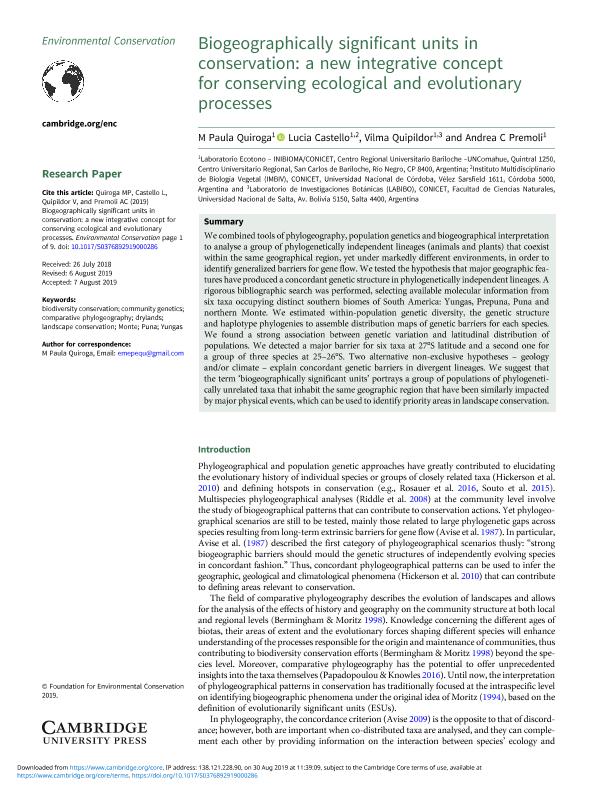Mostrar el registro sencillo del ítem
dc.contributor.author
Quiroga, Maria Paula

dc.contributor.author
Castello, Lucía Virginia

dc.contributor.author
Quipildor, Vilma

dc.contributor.author
Premoli Il'grande, Andrea Cecilia

dc.date.available
2021-01-08T14:45:51Z
dc.date.issued
2019-06
dc.identifier.citation
Quiroga, Maria Paula; Castello, Lucía Virginia; Quipildor, Vilma; Premoli Il'grande, Andrea Cecilia; Biogeographically significant units in conservation: A new integrative concept for conserving ecological and evolutionary processes; Cambridge University Press; Environmental Conservation; 46; 4; 6-2019; 1-9
dc.identifier.issn
0376-8929
dc.identifier.uri
http://hdl.handle.net/11336/121845
dc.description.abstract
We combined tools of phylogeography, population genetics and biogeographical interpretation to analyse a group of phylogenetically independent lineages (animals and plants) that coexist within the same geographical region, yet under markedly different environments, in order to identify generalized barriers for gene flow. We tested the hypothesis that major geographic features have produced a concordant genetic structure in phylogenetically independent lineages. A rigorous bibliographic search was performed, selecting available molecular information from six taxa occupying distinct southern biomes of South America: Yungas, Prepuna, Puna and northern Monte. We estimated within-population genetic diversity, the genetic structure and haplotype phylogenies to assemble distribution maps of genetic barriers for each species. We found a strong association between genetic variation and latitudinal distribution of populations. We detected a major barrier for six taxa at 27°S latitude and a second one for a group of three species at 25–26°S. Two alternative non-exclusive hypotheses – geology and/or climate – explain concordant genetic barriers in divergent lineages. We suggest that the term ‘biogeographically significant units’ portrays a group of populations of phylogenetically unrelated taxa that inhabit the same geographic region that have been similarly impacted by major physical events, which can be used to identify priority areas in landscape conservation.
dc.format
application/pdf
dc.language.iso
eng
dc.publisher
Cambridge University Press

dc.rights
info:eu-repo/semantics/openAccess
dc.rights.uri
https://creativecommons.org/licenses/by-nc-sa/2.5/ar/
dc.subject
BIODIVERSITY CONSERVATION
dc.subject
COMPARATIVE PHYLOGEOGRAPHY
dc.subject
COMMUNITY GENETICS
dc.subject
DRYLANDS
dc.subject
LANDSCAPE CONSERVATION
dc.subject
MONTE
dc.subject
PUNA
dc.subject
YUNGAS
dc.subject.classification
Biología

dc.subject.classification
Ciencias Biológicas

dc.subject.classification
CIENCIAS NATURALES Y EXACTAS

dc.title
Biogeographically significant units in conservation: A new integrative concept for conserving ecological and evolutionary processes
dc.type
info:eu-repo/semantics/article
dc.type
info:ar-repo/semantics/artículo
dc.type
info:eu-repo/semantics/publishedVersion
dc.date.updated
2020-11-19T22:54:47Z
dc.identifier.eissn
1469-4387
dc.journal.volume
46
dc.journal.number
4
dc.journal.pagination
1-9
dc.journal.pais
Reino Unido

dc.journal.ciudad
Cambridge
dc.description.fil
Fil: Quiroga, Maria Paula. Consejo Nacional de Investigaciones Científicas y Técnicas. Centro Científico Tecnológico Conicet - Patagonia Norte. Instituto de Investigaciones en Biodiversidad y Medioambiente. Universidad Nacional del Comahue. Centro Regional Universidad Bariloche. Instituto de Investigaciones en Biodiversidad y Medioambiente; Argentina. Universidad Nacional del Comahue. Centro Regional Universitario Bariloche. Laboratorio de Ecotono; Argentina
dc.description.fil
Fil: Castello, Lucía Virginia. Consejo Nacional de Investigaciones Científicas y Técnicas. Centro Científico Tecnológico Conicet - Patagonia Norte. Instituto de Investigaciones en Biodiversidad y Medioambiente. Universidad Nacional del Comahue. Centro Regional Universidad Bariloche. Instituto de Investigaciones en Biodiversidad y Medioambiente; Argentina. Consejo Nacional de Investigaciones Científicas y Técnicas. Centro Científico Tecnológico Conicet - Córdoba. Instituto Multidisciplinario de Biología Vegetal. Universidad Nacional de Córdoba. Facultad de Ciencias Exactas Físicas y Naturales. Instituto Multidisciplinario de Biología Vegetal; Argentina. Universidad Nacional del Comahue. Centro Regional Universitario Bariloche. Laboratorio de Ecotono; Argentina
dc.description.fil
Fil: Quipildor, Vilma. Consejo Nacional de Investigaciones Científicas y Técnicas. Centro Científico Tecnológico Conicet - Patagonia Norte. Instituto de Investigaciones en Biodiversidad y Medioambiente. Universidad Nacional del Comahue. Centro Regional Universidad Bariloche. Instituto de Investigaciones en Biodiversidad y Medioambiente; Argentina. Universidad Nacional de Salta. Facultad de Ciencias Naturales. Escuela de Agronomía. Laboratorio de Investigaciones Botánicas; Argentina
dc.description.fil
Fil: Premoli Il'grande, Andrea Cecilia. Consejo Nacional de Investigaciones Científicas y Técnicas. Centro Científico Tecnológico Conicet - Patagonia Norte. Instituto de Investigaciones en Biodiversidad y Medioambiente. Universidad Nacional del Comahue. Centro Regional Universidad Bariloche. Instituto de Investigaciones en Biodiversidad y Medioambiente; Argentina. Universidad Nacional del Comahue. Centro Regional Universitario Bariloche. Laboratorio de Ecotono; Argentina
dc.journal.title
Environmental Conservation

dc.relation.alternativeid
info:eu-repo/semantics/altIdentifier/url/https://www.cambridge.org/core/journals/environmental-conservation/article/biogeographically-significant-units-in-conservation-a-new-integrative-concept-for-conserving-ecological-and-evolutionary-processes/DD933997B7DE500273B194EFDFF6D80E
dc.relation.alternativeid
info:eu-repo/semantics/altIdentifier/doi/https://doi.org/10.1017/S0376892919000286
Archivos asociados
